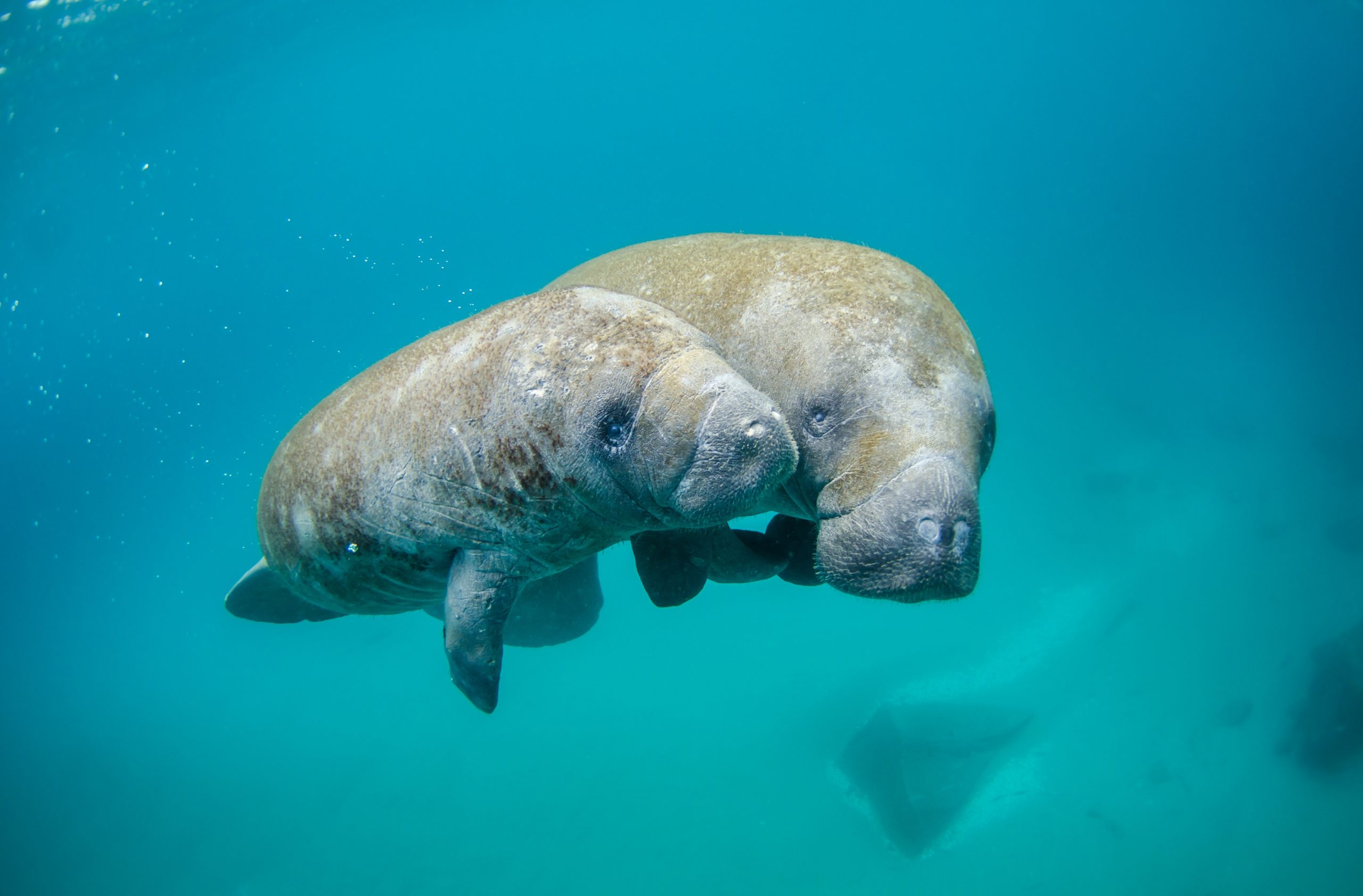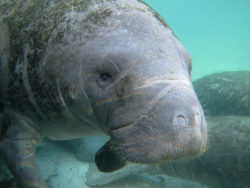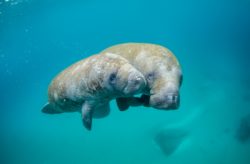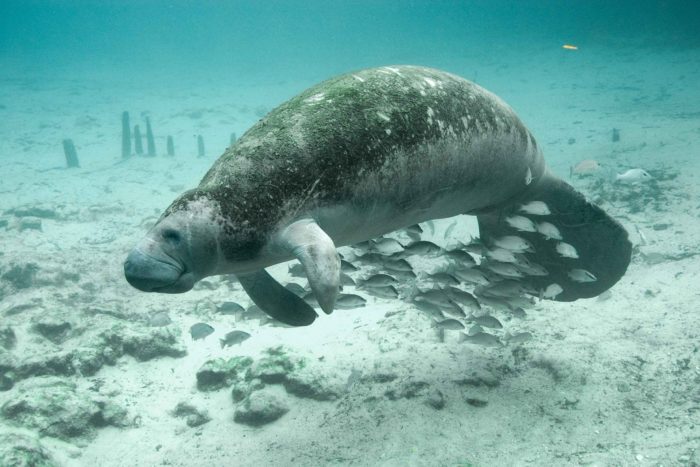
Sea Wonder: Manatees
 People all over the world admire manatees for their gentle nature and adorable appearance. In fact, they’ve earned the nickname of “sea cows” due to their slow nature and constant grazing which actually helps ensure vegetative balance in coastal marine ecosystems. Their health also serves as an important indicator to overall ecological well-being.
People all over the world admire manatees for their gentle nature and adorable appearance. In fact, they’ve earned the nickname of “sea cows” due to their slow nature and constant grazing which actually helps ensure vegetative balance in coastal marine ecosystems. Their health also serves as an important indicator to overall ecological well-being.
Description
Despite being marine mammals, manatees are actually more closely related to elephants than they are to whales and dolphins. Three species of manatees occupy the world’s ocean: the African manatee (Trichechus senegalensis), the Amazonian manatee, (Trichechus inunguis), and the West Indian manatee (Trichechus manatus). The West Indian manatee species includes two subspecies, the Antillean manatee and the Florida manatee.
Common characteristics across all three species include thick, rough, and wrinkled gray skin that covers their large, rounded bodies. They have two short pectoral flippers — one on each side of their body – used for steering, eating, and social behavior, and the bones within these flippers look similar to that of a human hand, arm, and shoulder. African and West Indian manatees have toenails on the front of their flippers that are similar to those of their elephant cousins; the Amazonian species does not have any toenails at all. At the back of their bodies are large, flat, paddle-like tails that manatees move up and down to move themselves through water at speeds of around five miles per hour, though they can reach speeds closer to 15 miles per hour in very short bursts if necessary. Their slow movement allows for algal growth on their backs.
Manatees’ charming faces may be what earns them their dedicated global fan club. They have rounded heads and no apparent neck, two tiny eyes, a large, flexible upper lip covered in whiskers (called vibrissae), two pronounced nostrils, and two tiny pinhole ears a few inches behind their eyes. Within their mouths are about 28 molar-shaped teeth that wear down from constant grazing. Throughout their lifetimes, manatees continually grown new teeth to replace those that wear down, which is why their teeth are sometimes referred to as marching molars. Since they are live-born mammals, manatees all have belly buttons located about halfway down on the underside of their bodies.
Average sizes and weights vary between the three species, but they can range from 900 to nearly 1,200 pounds when fully grown and between nine and 11 feet long. Unlike other marine mammals, they do not have blubber or dense fur to keep them warm in the water.
Diet and Habitat
Manatees are among the only herbivorous (plant-eating) marine mammals in the entire ocean – the other is the dugong, a close relative of the manatee – and are unique among marine mammals in that they have to actively drink fresh water instead of digesting it from the food they eat. Despite moving slowly, manatees need to maintain their large bodies by eating around 150 pounds of plant matter each day!
They are forage feeders that graze on vegetation that is submerged, floating, and even rooted on the shoreline. Examples include manatee grass, turtle grass, mangrove leaves, and marine algae. Manatee grazing behavior helps with seagrass growth, and healthy seagrass beds provide food and shelter for other species while storing atmospheric carbon that would otherwise contribute to anthropogenic climate change.
The dietary needs of manatees often dictate their location, but they tend to prefer calm waters near the coast, including freshwater rivers and canals. Since they don’t have blubber or fur, manatees are prone to cold stress and hypothermia and need to stay in warm waters, which can lead them to less-than-ideal places like the outflow canals of power plants. Because of this, they are considered a semi-migratory species. African manatees generally stay within the large rivers on the continent’s west coast; as their name suggests, Amazonian manatees reside in the Amazon river; and the West Indian manatee is found along Central American countries in the Gulf Coast, along the U.S. east coast (but primarily in Florida – including Florida Keys National Marine Sanctuary), the Caribbean, and the northern edge of South America.
Life History

Manatee calves are born after a year-long pregnancy and usually during the summer months. Because manatee mothers have to invest so much time and energy in raising a single calf, they usually give birth to one calf at a time and reproduce as frequently as every two years. Calves can weigh as much as 60 pounds and are about four feet long at birth and will travel with their mothers for about two years before going off on their own. Manatee calves nurse for well over a year and will begin supplementing their diet with grazing at only a few weeks of age. Adult females are capable of lactating whether or not they have been pregnant, so calves can nurse from females other than their mothers. Manatees exhibit unique nursing behaviors because their mammary glands and nipples are located behind the pectoral flippers or in their armpit area rather than on their underside.
Manatees spend most of their time sleeping and eating and can travel alone or in very small groups with no apparent social hierarchies beyond mother-calf pairs. To sleep, they lie on the seabed for about 12 hours, only traveling to the surface every 15 or 20 minutes to breathe. During foraging, manatees take breaths more frequently at intervals of about three to five-minutes.
When migrating, manatees seem to follow the warming water temperature rather than any individual animal, and in cold snaps large groups of manatees will huddle together for warmth. Mating season occurs when water is warm and food is plentiful, which means the later spring into early fall months can result in large mating herds in very shallow waters.
Threats and Conservation
In the United States, manatees are considered threatened under U.S. law and vulnerable by the IUCN due to challenges like cold stress, harmful algal blooms and red tides, boat strikes or other physical trauma, coastal development, habitat loss, and entanglement. They currently receive federal protection under the Marine Mammal Protection Act of 1972 and the Endangered Species Act and are protected at the state level under the Florida Manatee Sanctuary Act. Since manatees rely on shallow coastal habitats and are slow moving, they are easy to approach by boat or even from land. However, human interactions are their greatest threats, and trying to touch them or give them food or water from a hose is both dangerous and against the law.
Since manatees move so slowly, boat strikes are one of the most common injuries and causes of death, along with entanglement in fishing gear and other debris. Well-meaning citizens also mistake sleeping manatees with sick or injured ones. Because manatees are large, powerful animals and protected under the law, the best way to help an animal you think is in distress is by reporting the incident to either Florida’s Fish and Wildlife Commission at 1-888-404-3922 or, if you are outside of Florida, NOAA’s marine mammal stranding hotline at (866) 755-6622.

